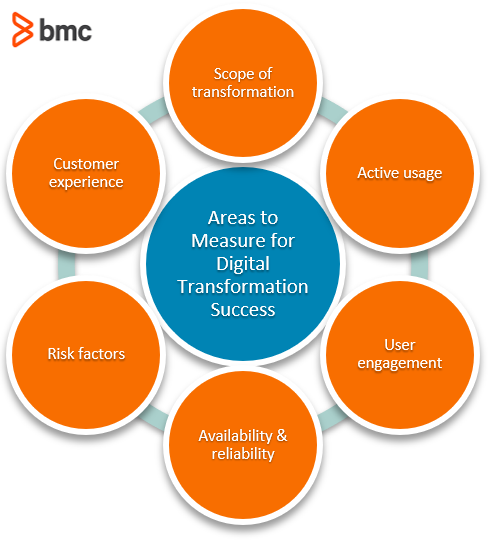Change is hard, digital transformation is harder.
Digital transformation (DX) is a challenging initiative. Many organizations are pursuing large-scale change efforts—yet less than 30% succeed. Traditional industries such as automatics, infrastructure, oil and gas, and healthcare among others find it even more challenging: only 11% succeed with digital transformation.
Many organizations take this approach to digital transformation projects: digitizing the operating model of the business. Organizations use technology to replace slow and error-prone manual processes with scalable and automated digital workflows. (There are actually three strategic areas crucial to any DX effort.)
Accordingly, to measure the success of their DX initiatives, organizations rely on metrics that track financial and operational efficiency. The problem, however, is these metrics aren’t always effective in measuring the success of a digital transformation program. According to McKinsey’s Digital Quotient analysis, less than 15% of organizations using financial Key Performance Indicators (KPIs) are able to accurately quantify the ROI on digital transformation investments. Common causes include:
- The slow budgetary cycle
- The lagging response of digital technologies on financial performance
So, here, we’ll look at a variety of metrics and KPIs that are better suited to determine whether you’re succeeding at digital transformation. Let’s get started.
Digital transformation metrics
Instead of relying on traditional benchmarks and metrics, the following measures can provide a significantly more insightful view of your digital transformation success:

Scope of transformation
Quantify the scope of what you’re aiming to achieve through digital transformation. Are you able to reach a wide and global user base? What proportion of your manufacturing assembly line workflow is automated? Some metrics examples include:
- Number of unique visitors
- Month-on-month (MoM) growth in registrations
- Organic user acquisition
- Manual hours invested per manufactured item
Active usage
Successful digital transformation requires sustainable adoption of the technology. Users registering for technology integrate that technology in their jobs or daily lives as a necessary replacement to manual alternatives.
The following metrics examples can help identify active usage among the registered user base:
- Daily Active Users
- Ratio of new users to repeat users
- Conversion rates
- Abandon rates
User engagement
From a user perspective, the technology should be sufficiently impactful to their jobs to warrant regular engagement. If users aren’t engaging the way you’d like, it’s because your technology isn’t useful enough for them to switch from their current work pattern, which might include manual processes and/or other tech solutions.
Insights on features and functions of the technology that are popular among the users can help the organization understand the usage patterns and perform appropriate improvements in future product releases. Metrics describing usage patterns and trends include:
- Net Promoter Score (NPS)
- Traffic sources
- Customer Satisfaction Index
- Bounce rate and exit rate
Availability and reliability
Transforming operational workflows that rely on legacy technologies or manual processes can lead to reliability challenges. For example, migrating legacy-dependent components of apps or IT workloads to the cloud can:
- Break the apps or workloads
- Cause performance issues down the road
That’s why you should evaluate system performance and keep an eye out for possible reliability issues. Some of the common metrics providing this insight include:
- Uptime
- Mean Time to Failure (MTTF)
- Mean Time to Resolve (MTTF)
- Mean Time Before Failure (MTBF)
Risk factors
The long-term viability of digital transformation requires strategic investments in reducing risk associated with the technologies. As more assets become digital, organizations must evaluate the risks surrounding cybersecurity and data privacy.
The following metrics can help them assess the security posture as the transition to a highly connected and globally accessible digital technology infrastructure:
- MTTF, MTTR, MTBF…
- Frequency of access at various privilege levels
- Data transfer volumes
- Number of systems with known vulnerabilities
Customer experience
Finally, it’s important to evaluate user perception of the technology, since end-user satisfaction ultimately determines how well the technology investments translate into the desired financial and organizational improvements. Some common metrics to evaluate user satisfaction include:
- Customer Satisfaction (CSAT)
- Customer Effort Score (CES)
- Customer Loyalty Index (CLI)
- Sentiment Analytics
Additional KPI themes
Other areas to measure around KPI themes can include:
- Employee performance
- Operational performance
- Innovation
- Financial performance
Choosing digital transformation metrics
Once you’ve defined and selected the metrics you’ll use, it’s important to find the inflection point of the digital KPI growth trajectory.
For example, you’ll maximize the financial ROI and operational efficiency from digital transformation when 80% of the user base adopts the technology. Increasing the adoption rate may require a disproportionately high amount of financial investments and changes to the organizational policy, which can ultimately cause the digital transformation project to fail.
Therefore, it’s important to follow industry proven best practices that have enabled industry leaders to push the boundaries with their digital transformation projects:
- Define specific KPI objectives that align with your organizational goals.
- Focus on a limited set of metrics that are most relevant to achieving these goals.
- Ensure that the measurements can be accurately benchmarked against past performance or accurate industry-accepted benchmark data.
- Ensure that the metrics are quantifiable, accurate, and insightful.
- Gain stakeholder buy-in to ensure organization-wide acceptance of the metrics results.
Additional resources
For related reading, explore these resources:







